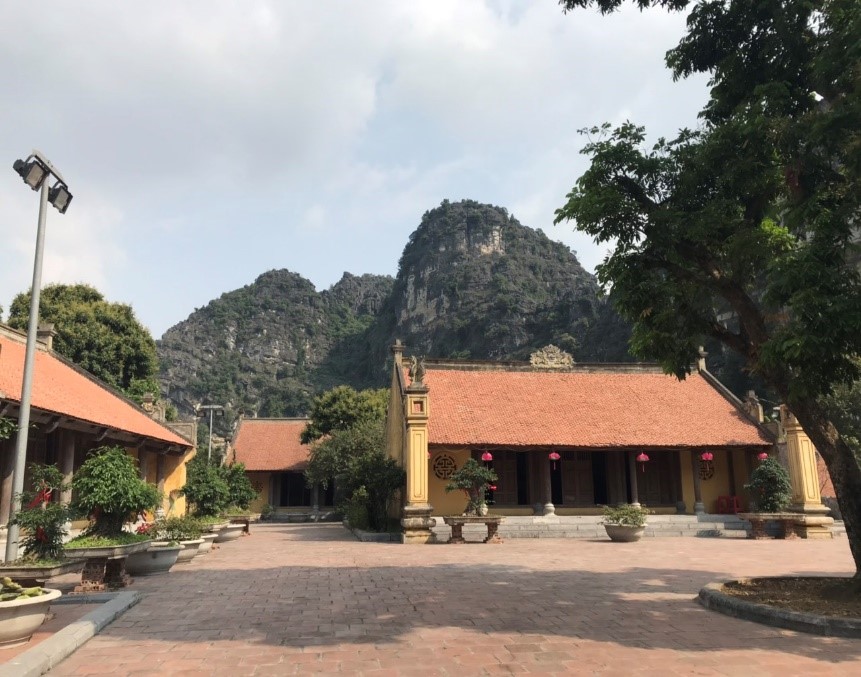Kim Ngan pagoda is an ancient temple in the special national relic area of Hoa Lu Ancient Capital. The pagoda is located in Chi Phong village, Truong Yen commune, Hoa Lu district, Ninh Binh province.
Legend has it that the pagoda was built in the 10th century, on the "warehouse foundation" for keeping gold and silver of the Dinh and pre-Le dynasties, so it is also known as Kim Ngan pagoda (Golden Pagoda). In addition, the pagoda is also called Ngan pagoda because it was built on the territory of Dong Ngan, surrounded by mountains on all sides, creating a majestic position, bordering Quen Vong (the place connecting the outer and inner citadel of Hoa Lu capital).

Panoramic view of Kim Ngan Pagoda
Over the years, the pagoda has been restored a number of times. Up to now, the pagoda is basically in the architectural style of the Nguyen dynasty.
The pagoda was built on a fairly flat and airy land, with an area of about 2000m2, architecture in the style of small space at the back of the temple, facing West - South. The temple campus includes the following works: Tam Quan, Upper Palace, Tomb house, Thap tomb, guest house...
With the traditional architectural style of the pagoda, it is roofed with male tiles, the wooden column system is placed on the stone legs. Artists have skillfully carved themes about dragons, stylized flowers, seal lines... with high sculptural value. These images not only make the architecture more beautiful but also make the space fanciful and sacred.
In the 10th century, the land with vestiges belonged to the inner citadel of Hoa Lu Capital, the first capital of the centralized feudal state of Vietnam. The couplets in front of the Tien Bai court praised the spirit here:
“Cổ bát sinh hoa, non phong thiên thu dụng khí tốt
Bồ đề kết quả, chi đình vạn thế ngưỡng linh thanh”
The main hall is decorated with 5 rows of statues:
In the first row, there are three statues of Tam the: Qua khu, Hien tai, Vi lai.
The second row is decorated with statues of Amitabha, Guan Yin Bodhisattva and Dai The Chi Bodhisattva.
The third row is the newborn Shakyamuni sitting on the Cuu Long throne
The forth row: Statues of Earth, Saint Sangha.
The fifth row: Statues of Monsignor, Saint Hien.
In addition to the statue system, the pagoda still preserves a number of precious artifacts such as bronze bells (first year Thanh Thai: 1889), incense sticks, incense bowls, couplets, hammock doors...
Every year, the pagoda organizes a festival on the full moon of January, during the festival, there is a ceremony to process the Dragon boat from the temple to the Bo De river wharf (Sao Khe). This is a festival that is both traditional and folk beliefs: Praying for good luck, praying for good weather and good crops.
During the two national wars against the French and the Americans, Kim Ngan Pagoda made many contributions to the resistance war. The pagoda was honored to be awarded the 3rd class Order of the Resistance against America for National Salvation (3rd December, 1992). Military Region 3 Command awarded certificates of merit (12th December, 1969). Ninh Binh Red Cross Society presents certificates of merit (20th November, 1997).
In 2000, with outstanding historical and cultural values, the pagoda was recognized as a national monument by the Ministry of Culture and Information.
Kim Ngan Pagoda together with Am Tien Pagoda, Duyen Ninh Pagoda, Co Am Pagoda, Nhat Tru Pagoda are ancient temples related to the Dinh and Pre-Le dynasties, located adjacent to each other in the Hoa Lu Ancient Capital, creating into a cluster of monuments diverse in architecture and fine arts, in harmony with the landscape.
With the shape of mountains, interesting caves, and the skillful hands of our forefathers, through many generations of construction, molding and embellishment, Kim Ngan Pagoda is indeed a fairy place with many mystical, sacred. Moments of sightseeing and worshiping Buddha at Kim Ngan Pagoda; and a series of visits to the monuments in the complex of historical and cultural relics of the ancient capital of Hoa Lu will bring visitors many unexpected and fascinating things.